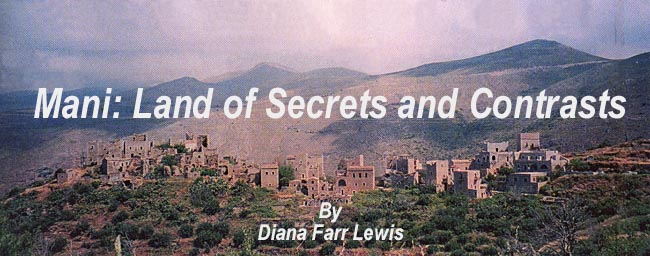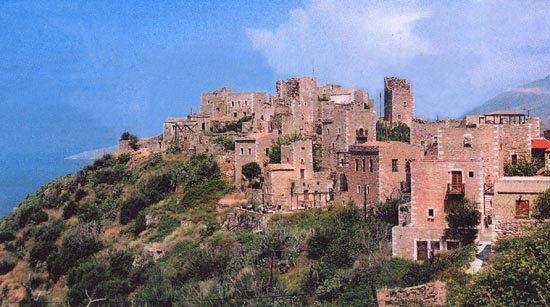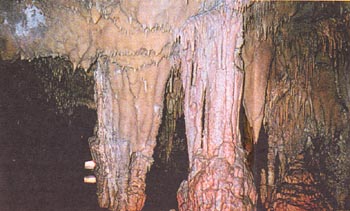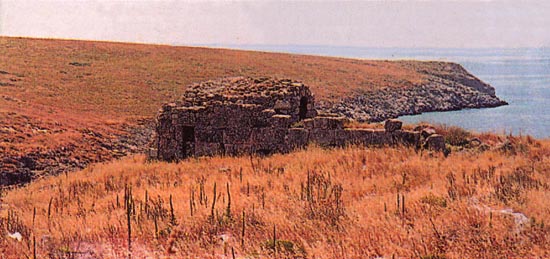 |
||
|
|
||
 Panoramic view of Vatheia--photos also by Diana Farr Lewis |
||
Athens News This is the second of two articles about the Mani, the central finger of the Peloponnese. An imaginary line from Itylo to Gytheio divides the peninsula into the Outer Mani and the Deep Mani. |
||
 Close-up image of the towers of Vatheia |
||
On the other hand, as unthreatening travellers were quick to notice, the Maniots may have been fierce warriors and ruthless pirates, but they were and still are unfailingly hospitable and generous to strangers. They're beginning to make money off them, too, as they convert towers into hotels or sell them to northerners hungry for undiluted doses of sunshine. While many hamlets remain hauntingly derelict, many more are being painstakingly restored. Nevertheless, don't expect bars or even shops in any but the very biggest towns. Forewarned is forearmed, so off we go. From Kardamyli south as far as Itylo, the transition from lush to bare occurs slowly, and the road slices through one charming village after another, passing a succession of eye-catching churches with high domes and intricate brickwork. After Langada, the olive trees start shrinking to bush height and the cypresses turn pencil-thin, a sign that we're about to cross from Messenia into Lakonia and the Inner Mani. The first town here is Itylo, whose name appears on Homer's list of the ships that sailed with Agamemnon to Troy. Many hundreds of years later it belonged to the Union of Free Lakonian Cities, fostered by the Romans to keep Sparta under control, but any antiquities have long since vanished either under the sea or into the foundations of newer buildings. Below Itylo lies a deep bay dotted with fishing villages ranging in age from venerable to not-quite-finished-neo-Greek cement beach cottages and small hotels mingling awkwardly with the dignified stone architecture of the past and a brand new "traditional Maniot village," Neo Limeni. But in the 17th century, Oitylo--as it was known then--was the Mani's chief city and (old) Limeni its main port, and that is why looming above the two you see the forbidding walls of Kelefa, the fortress built by the Turks to remind the Maniots that the sultan was boss. A similarly strategic castle above Porto Kayio at the southeast tip of the peninsula ensure the occupiers a eagles' view of the sea routes between Mani, Kythera and Crete. Areopolis, next stop on the road, seems more a busy farming town than a warlord' s stronghold, but this was where the Mavromichalis clan had their base. On March 17, 1821, Petrobey Mavromichalis, chieftain of that most powerful of all the Mani families, decided the time had come to throw the Turks out. Having achieved the impossible in uniting the other Maniot tribes behind him, he marched them up the coast to Kardamyli, where Kolokotronis and Mourtzinos were waiting and, on March 23, their combined horde of 3,000 fighters stormed the Turkish garrison at Kalamata. Two days later, Archbishop Germanos raised the banner of Liberty at Kalavryta and Greeks from Epirus to Crete, Chios to Spetses rose up against their rulers. More than a decade afterwards, when the war was over and at least some Greek territories freed, Petrobey found himself in a Nafplio jail over some disagreement with Governor Capodistrias. Incensed at the ignominy, the Mani erupted again, and two of Petrobey's nephews assassinated Capodistrias. Petrobey's reputation remained unscathed, however, and on his return, his birthplace was renamed Areopolis--city of the god of war--in his honour. Up to then it had been called Tsimova, a hint that the Slavs who had terrorised the Peloponnese many centuries earlier had penetrated this far into the Mani. |
||
| South of Pyrgos Dirou, the uncharacteristically straight road takes you past one semi-deserted tower hamlet after another. One of them is Kitta, scene of the Mani's final vendetta in 18970. Bob Barrow writes that it took "400 regular troops with artillery support" to suppress the fighting between the two families. These feuds, which often lasted decades, could be started on a pretext--a supposed insult, too long a glance at a daughter--but their real motive was to gain control of a precious well or a field where a few stalks of wheat could grow amongst the stones. Down here the low,empty Sangria mountains have another name in local parlance: the Kakovounia or Bad Mountains. By a convenient slip of the tongue, Kakovounia became Kakovoulia, or Evil Counsel, an epithet that fit nicely with the Maniots' reputation. Leigh Fermor preferred to think the slur derived from the three-legged cooking pots their pirates were said to have worn as helmets; translated, that would have meant the rather innocuous "country of the Cauldroneers." |
 Pirgos Dirou caves |
|
Over a late lunch at Tsitsiri Castle-Hotel in Stavri, happy recipients of a more conventionally used cooking pot, we asked the proprietor Antigone Elafaki-Koulourianou about life today. "Water is still a problem," she said. "It had to be brought in by tanker trunk until a couple of years ago. The electricity is so erratic that the Deep Mani has no banks--they can 't run their computers. But we're not remote any more. People come from as far away as Larissa just for the weekend." |
||
 Cape Tainaron's Agii Asomati Church was put together with blocks from the temple of Poseidon. The supposed entrance to Hades is just below to the left. |
||
|
That afternoon I took a walk to one of Michael Cullen's "favourite picnic spots." Although his directions could not be faulted, I stood at the edge of the cliff looking vainly for the little chapel of the Virgin Odigitria that was my goal. So well camouflaged was it amongst the rocks and thistles, I would have missed it if a threesome of Greek hikers hadn't happened along. Michael was right; the setting was superb. Birds soared below me; Easter lilies, pink and mauve stock and yellow everlastings decorated the path; and the walls of the massive fortress of la Grande Magne stood out clearly above the Tigani, a jagged appendage that juts into the sea like a giant's frying pan. But I was left with two logistical problems to ponder: why and how did the Franks erect a castle in such an inaccessible spot and why and how did present day Greeks plant several heavy orang (!) chairs and a picnic table on the tiny ledge in front of the 13th-century chapel? From Stavri, a collection of tower-houses being lovingly restored without dislodging resident owls, we whizzed through the morose port of Yerolimenas and on to Vatheia. Vatheia epitomises the Mani tower-village. Built along the ridge of a low hill, its severe geometry stands out against the skyline like a mini-Manhattan. Not long ago people were queueing up to stay here. The National Tourism Organisation loaned money to restore the towers, provided that the owners operated them as hotels for a certain number of years. Who knows what went wrong? The time ran out and so did the owners. Now Vatheia is a ghost town again, with just one cafe. Europe's tip As you approach the bottom of Mani, the views are car-stopping, with the half-moon bays of Marmari and Porto Kayio on either side of a boulder-strewn neck of land that bulges out again before coming to a needle-sharp tip at Cape Tainaron or Matapan. Years ago I watched an old woman cast a net for quail on the cliff above the bay named for them. She could have been fishing the air. Here at what feels like the end of the world but is really only the southeast end of continental Europe, both myth and civilisation thrived in ancient times. Orpheus and Hercules were said to have descended into Hades through a cave in the last bay before the cape (although it is disappointingly short and unspooky); near it Poseidon had a renowned temple, which has disappeared under the squat, primitive looking Byzantine church of Agii Asomati; and ruins of a substantial city sprawl over both sides of the bay. Among the overgrown cisterns, walls, and terraces, we stumbled upon a mosaic floor. Black circles with curlicues set around a stylized six-petalled flower on a white background, its sophistication and delicacy came as a shock in this wild outpost. But in a way that mosaic symbolises the surprises and contrasts of the Mani. The region can seem either stern and riddled with dark memories or flooded with light and warmth. The lines of the towers are sharp but the churches have soft contours and embroidered facades. The mountains may look bare but are thickly tufted with thyme, rigani, St. John's wort, and sage. So scratch beneath the surface when you make this trip, walk through the ghost towns and into the hills, and be sure to spend at least one night in a converted fortress. But if you still hanker for the greener, gentler side of Mani, then head north for Skoutari and Kotronas where there is a pretty collection of beaches, coves and bungalows. How to get there There are buses from Kalamata and Gytheio to Itylo, Areopolis and Yerolimenas, if you don't have a car. You can enter the Inner Mani via Kardamyli or Gytheio, and either make the whole circle down to the tip and back up the other coast or cross over Taygetos between Areopolis and Kotronas or Gytheio. The main roads are narrow but the surface is usually acceptable. Where to stay Areopolis has two wonderful possibilities in old tower houses: Londas (tel 27330-51360) with only four rooms and Pyrgos Kapetanakou (tel 27330-51233) with six. Both are beautifully furnished and well-kept and the latter has a garden. The thick-walled Tsitsiri castle (tel 27330-56297) in Stavri, near the Tigani peninsula, is attractive, if a bit run down, and its vaulted cellar restaurant serves more than atmosphere. Friends recommend the simple rooms run by a jovial priest at the late 20th-century castle above the beach at Marmari (tel 27330-21620). [edd: from the U.S., use the prefixes 011-30 for all Greek phone numbers listed in this article] Where to eat We ate well at Tsitsiri Castle--Antigone Elafaki-Koulourianou adds her own original twists to traditional dishes--and at Papayiorgis' Castle at Marmari (ask for his mother's baked cheese with wine, herbs, capers and olives). There are fish restaurants at all the villages on the tip--Gerolimenas, Porto Kayio--and Limeni near Itylo further north on the west coast has a famous one called O Takis (tel 27330-51327). Extra reading Patrick Leigh Fermor, Mani: Travels in the Southern Peloponnese; John Murray, London, 1958, but since reprinted. Bob Barrow, The Mani; Thomeas Travel Services, Stoupa, no date. Michael Cullen, Landscapes of the Southern Peloponnese; Sunflower Books, London, 2003. |
||
(Posted originally July 2005; reformatted February 2007) HCS readers can view other excellent articles by Diana Farr Lewis in the Travel in Greece section of our extensive, permanent archives at the URL http://www.helleniccomserve.com./contents.html. She is a journalist and writer for the English-language Athens News. Readers enjoying her articles may wish to view other fine selections of the Athens
HCS also recommends viewing A Picture Bible of Mani--an stunning collection of historical photographs by noted photographer Yiannis Vourlitis, some of whose images appear in a review and release posted on HCS: http://www.helleniccomserve.com/manibiblehcsreview.html. HCS has two other articles about Mani: "The Lighthouse of Kitries," (http://www.helleniccomserve.com/lighthouse.html) and "A Brief History of the Balteas Family" (http://www.helleniccomserve.com/Balteas1.html). For additional information about Mani, visit the website of Adouloti Mani Publishing House (http://www.mani.org.gr/adoulotimani/ekdoseis.htm), producers of fine books about Mani and the periodical Mani:Yesterday,Today,Tomorrow: http://www.mani.org.gr/periodikomani/. |
||
|
|
||
|
2000 © Hellenic Communication Service, L.L.C. All Rights Reserved.
http://www.HellenicComServe.com |
||

